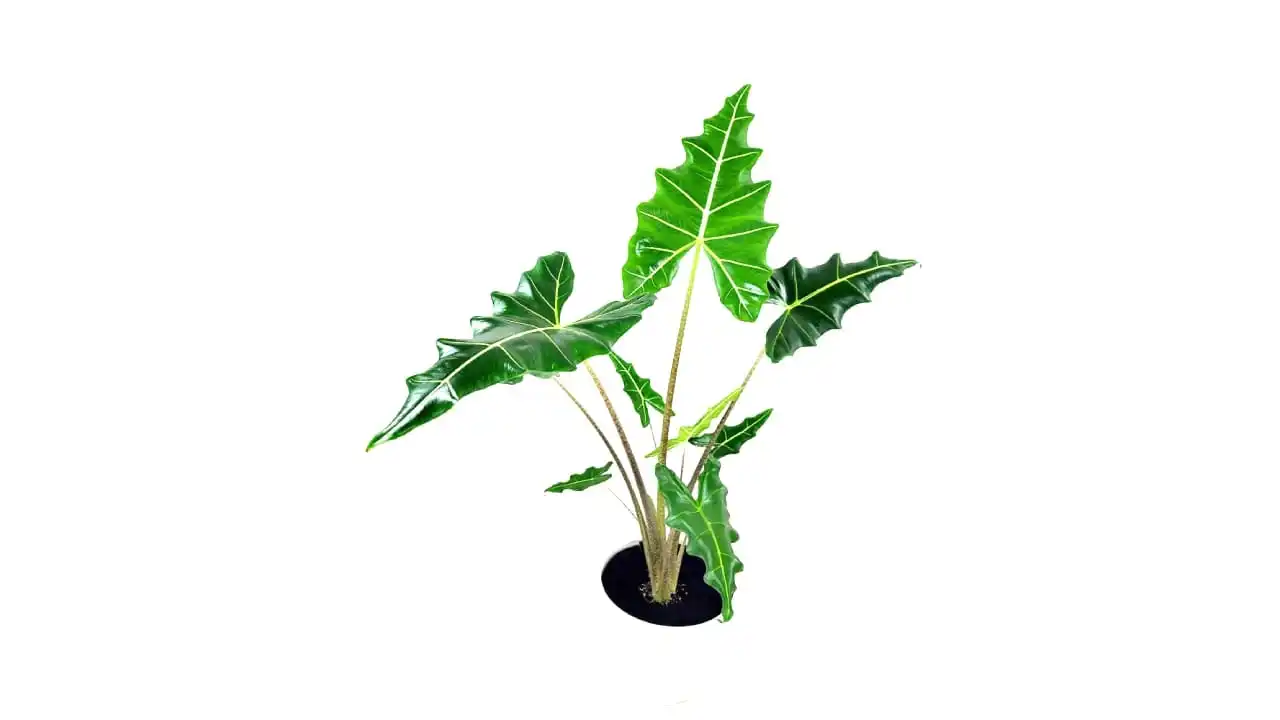Introduction
Alocasia Sarian, frequently denoted as the Jewel Alocasia, stands as an enchanting botanical species cherished for its remarkable foliage and exotic charm. Emerged from Southeast Asia, notably the rainforests of Borneo, this floral treasure has attained global admiration among botanical aficionados. Within this extensive guide, we venture into the captivating domain of Alocasia Sarian, delving into its inception, horticultural methodologies, nurturing recommendations, and much more.
Quick Overview
| Common Name | Elephant Ear |
| Scientific Name | Alocasia ‘Sarian’ |
| Sun Exposure | Partial |
| Soil Type | Most But Well-Drained |
| Soil pH | Acidic, Neutral |
| Family | Araceae |
| Mature Size | Up to 5 Ft. Tall Indoors, and 12 Ft. Tall Outdoors |
| Plant Type | Perennial, Bulb |
| Native Area | Philippines |
| Toxicity | Toxic to Dogs, Cats, Horses And People |
Origins and Habitat
Indigenous to the verdant rainforests of Borneo, Alocasia Sarian flourishes in balmy and humid habitats distinguished by filtered sunlight and fertile, well-drained soil. It pertains to the Araceae botanical family and shares close kinship with other renowned Alocasia cultivars such as Alocasia Amazonica and Alocasia Polly.
Appearance and Features
Alocasia Sarian possesses expansive leaves, reminiscent of an artist’s intricate brushstrokes, displaying intricate veining patterns. Its foliage presents a captivating fusion of deep green tones, accented by prominent ivory veins, resulting in a visually stunning spectacle. With mature specimens towering to heights of approximately three feet, Alocasia Sarian emerges as a striking centerpiece, whether gracing indoor sanctuaries or outdoor landscapes.
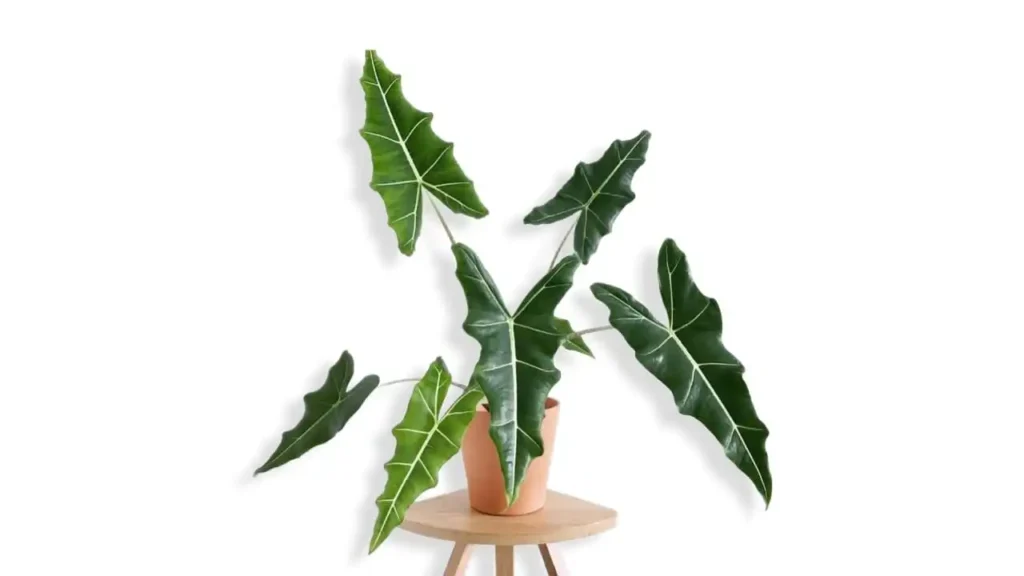
Read Me – Swiss Cheese Plant: The Ultimate Care And Growing Guide
Caring: Cultivating For Your Alocasia Sarian
Cultivating your Alocasia Sarian involves nurturing it like a cherished confidant – it demands a precise concoction of attention and fondness to thrive. Throughout this segment, we’ll navigate you through the intricacies of tending to your verdant comrade, enveloping a spectrum of fundamentals from illumination and hydration to temperature and affectionate care.
Sunlight Embrace: Your Alocasia Sarian flourishes within the tender embrace of sifted sunlight. Picture it as offering a snug alcove by the aperture, where it can imbibe the sun’s beams without experiencing overheating.
Watering Insight: Envision satiating your flora’s parchedness with a sip, not inundating it in a downpour. Uphold the soil’s consistent moisture, permitting the superficial layer to desiccate marginally between waterings. It’s all about striking a subtle equilibrium – adequate to quench its thirst without asphyxiating its roots.
Temperature TLC: Alocasia Sarian revels in a warm and snug habitat, reminiscent of cuddling beneath a snug throw. Uphold temperatures within the range of 65°F to 80°F (18°C to 27°C), evading brisk drafts that could elicit shivers down its foliage.
Humidity Harmony: Convey your vegetation to its sanctuary with a hint of moisture. A spray here, a mist there – fabricate a microenvironment that mimics its equatorial ancestry, nurturing opulent expansion and resplendent foliage.
Nutritional Provision: Indulge your Alocasia Sarian in a sumptuous repast during its maturation period. A diluted measure of aqueous manure furnishes the quintessential boost, stoking robust development without inundating its frail framework.
Leaf Fondling: Bestow upon your flora some tender affection by delicately caressing its leaves. It’s tantamount to offering it a revitalizing cleanse, rinsing away debris and filth to unveil its innate loveliness.
With these personalized nurturing methodologies at your disposal, you’ll embark on a voyage of cultivating your Alocasia Sarian into an emerald opus, lauded by all who encounter its effulgent demeanor.
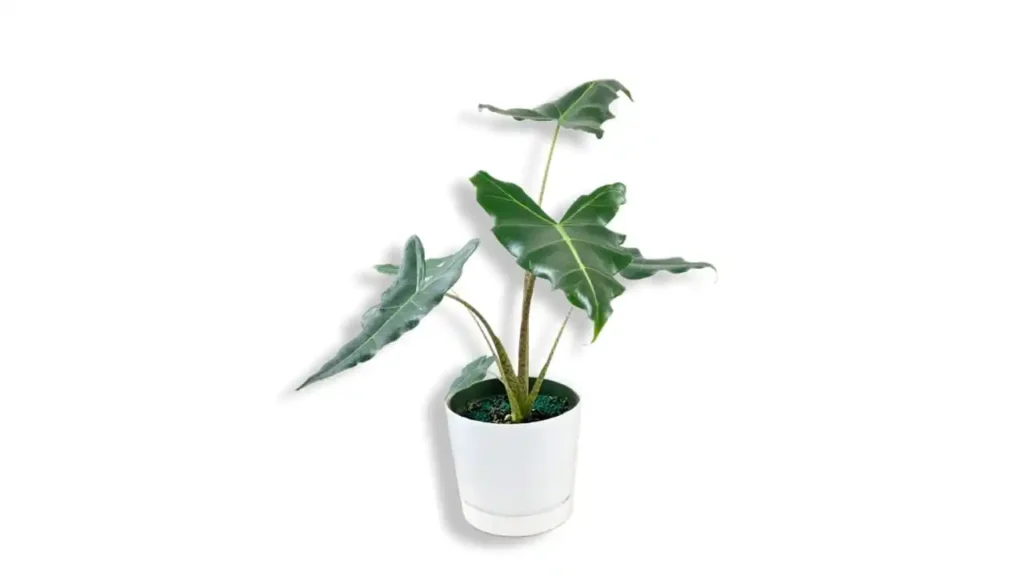
Propagation: Expanding Your Greenery Clan
Are you captivated by the grace of Alocasia Sarian and eager to nurture its allure further? Well, prepare yourself for a captivating expedition because fostering this exquisite botanical specimen is more straightforward than anticipated. Let’s explore two elemental techniques: division and offset collection.
Division:
Imagine granting your Alocasia Sarian some breathing space. When it starts to feel snug within its confines, it’s time for a subtle repositioning. Gently coax your plant from its enclosure, delicately unraveling the tangle of roots, ensuring each segment boasts robust roots and a smattering of stems. Then, transfer them to fresh vessels brimming with a top-tier potting blend. Offer a gentle quenching, and observe as they luxuriate in their newfound expansiveness.
Offset Collection:
Offsets resemble the vivacious siblings of your Alocasia Sarian, eager to chart their own course. They emerge at the foot of the principal plant, primed for independence. To gather them, delicately detach them from the parent, ensuring they bear their miniature root systems. Then, it’s time for them to carve their niche. Plant them individually in receptacles filled with well-draining substrate, administer a tender watering, and marvel – you’ve just inducted new members into your verdant kin.
Propagating Alocasia Sarian transcends mere numerical augmentation; it’s about fostering a thriving community of botanical wonders. With delicate nurturing and a dash of forbearance, you’ll soon find yourself ensconced amidst a kaleidoscope of these extraordinary plants, each exuding its distinct allure.

Potting & Repotting: Creating a Comfortable Habitat
Potting and repotting constitute fundamental elements of nurturing your Alocasia Sarian, ensuring the provision of an apt growing milieu and ample space for root expansion. Prudent potting and repotting methodologies substantially contribute to the plant’s robustness, vitality, and holistic welfare.
Choosing the Right Pot
The initial stride in potting your Alocasia Sarian is the discerning selection of an apt receptacle. Opt for a vessel equipped with sufficient drainage orifices to preclude waterlogging, as an inundation of moisture might precipitate root decay. Furthermore, opt for a pot endowed with ample breadth and profundity to accommodate the plant’s intricate root architecture and facilitate prospective proliferation.
Selecting the Potting Mix
The adoption of a well-aerated potting concoction is paramount for the Alocasia Sarian, serving to deter aqueous accumulation around the root system while fostering robust growth. Contemplate the amalgamation of peat moss, perlite, and organic compost to ensure the optimal balance between aeration and moisture retention. Eschew ponderous substrates are susceptible to compaction over time, thereby impeding root elongation.
Potting Procedure
Commencing the potting process necessitates the deposition of a stratum of potting blend at the receptacle’s base, ensuring its envelopment of the drainage apertures. Gently extricate the plant from its extant container, exercising caution to avert damage to the root structure. Situate the plant centrally within the novel pot and enrobe the roots with additional potting concoction, exerting mild compression to confer stability.
Repotting Timing
A cognizance of the opportune moment to report your Alocasia Sarian underscores its sustained proliferation and vitality. As a general tenet, embark upon repotting endeavors biennially or when the plant outgrows its present container. Manifestations suggestive of the exigency for repotting encompass root protrusion through the drainage orifices, stunted vegetative advancement, or a desiccated substrate.
Repotting Process
During the repotting procedure, methodically extricate the plant from its incumbent receptacle and scrutinize the root system for indications of overcrowding or root entanglement. Subsequently, should the exigency arise, gingerly disentangle the roots and excise any compromised or necrotic segments. Opt for a receptacle of slightly superior dimensions vis-à-vis its antecedent and execute the potting protocol delineated above.
Aftercare
Subsequent to the potting or repotting episode, bestow upon the Alocasia Sarian a copious libation to consolidate the substrate and instigate root establishment. Position the receptacle in an environment bathed in diffused luminosity, averting direct solar irradiation that might inflict foliar desiccation. Exercise vigilant oversight over the ensuing weeks, calibrating the frequency of irrigation as necessitated to perpetuate optimal hydric equilibrium.
Adherence to these potting and repotting precepts will ensure the endowment of ideal vicissitudes for your Alocasia Sarian, thus facilitating its efflorescence and proliferation within its newfound domicile.
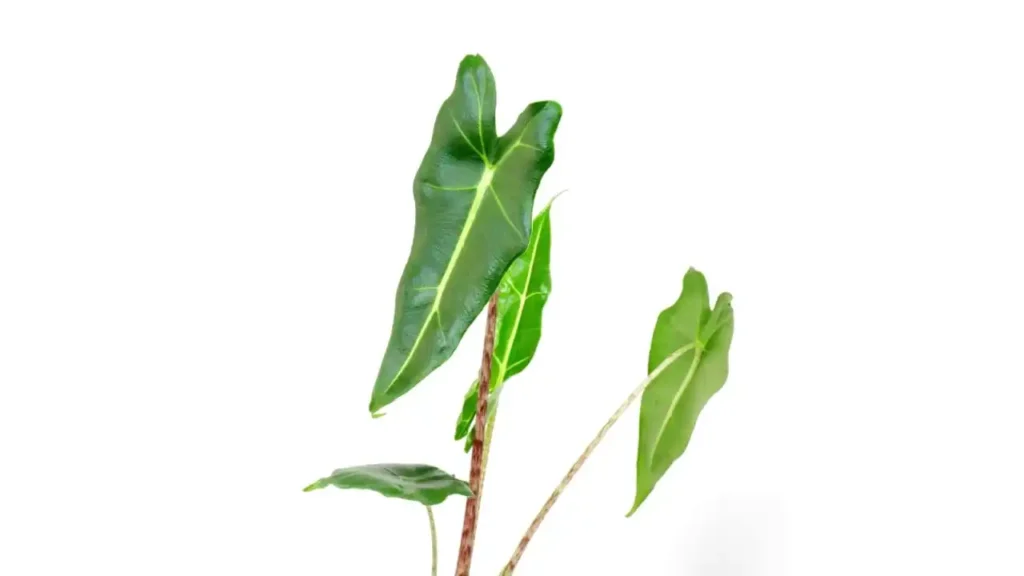
Pests & Diseases: Dealing with Uninvited Guests
Alocasia Sarian, akin to numerous flora, may fall prey to pests and ailments that jeopardize its well-being and aesthetics. Identifying and promptly remedying these concerns proves vital in preserving the vigor of your botanical companion.
Uncommon Pests
Aphids: These diminutive, sap-consuming creatures may congregate beneath leaves, inducing them to contort and deform.
Mealybugs: These insects manifest as pale, woolly clumps on foliage and stems, subsisting on plant fluids and secreting honeydew.
Spider Mites: These minuscule arachnids thrive in arid conditions, inflicting stippling and ensnaring leaves in webbing.
Mitigation and Rectification
Systematically scrutinize your Alocasia Sarian for indications of pest colonization, particularly on the ventral sides of the leaves.
Employ a gentle misting of water to displace pests or utilize a soft fabric to eradicate them.
In instances of severe infestation, contemplate resorting to organic insecticidal soap or neem oil to suppress pests while mitigating harm to beneficial organisms.
Uncommon Disorders
Root Deterioration: Excessive irrigation or suboptimal drainage may precipitate root decay, resulting in soggy, discolored roots. This, in turn, may culminate in wilting and chlorosis of foliage.
Fungal Afflictions: Pathogens such as leaf blotch and powdery mildew can thrive in muggy conditions, materializing as lesions or powdery, alabaster patches on leaves.
Mitigation and Rectification
Adhere to appropriate irrigation practices, permitting the substrate to modestly desiccate between waterings to preclude root deterioration.
Enhance air circulation surrounding the specimen to diminish humidity and mitigate the likelihood of fungal incursions.
Should fungal maladies ensue, excise affected foliage and apply fungicidal solutions as directed.
Through vigilant and preemptive intervention in pest and malady abatement, you can nurture your Alocasia Sarian and sustain its verdant foliage for an enduring duration.
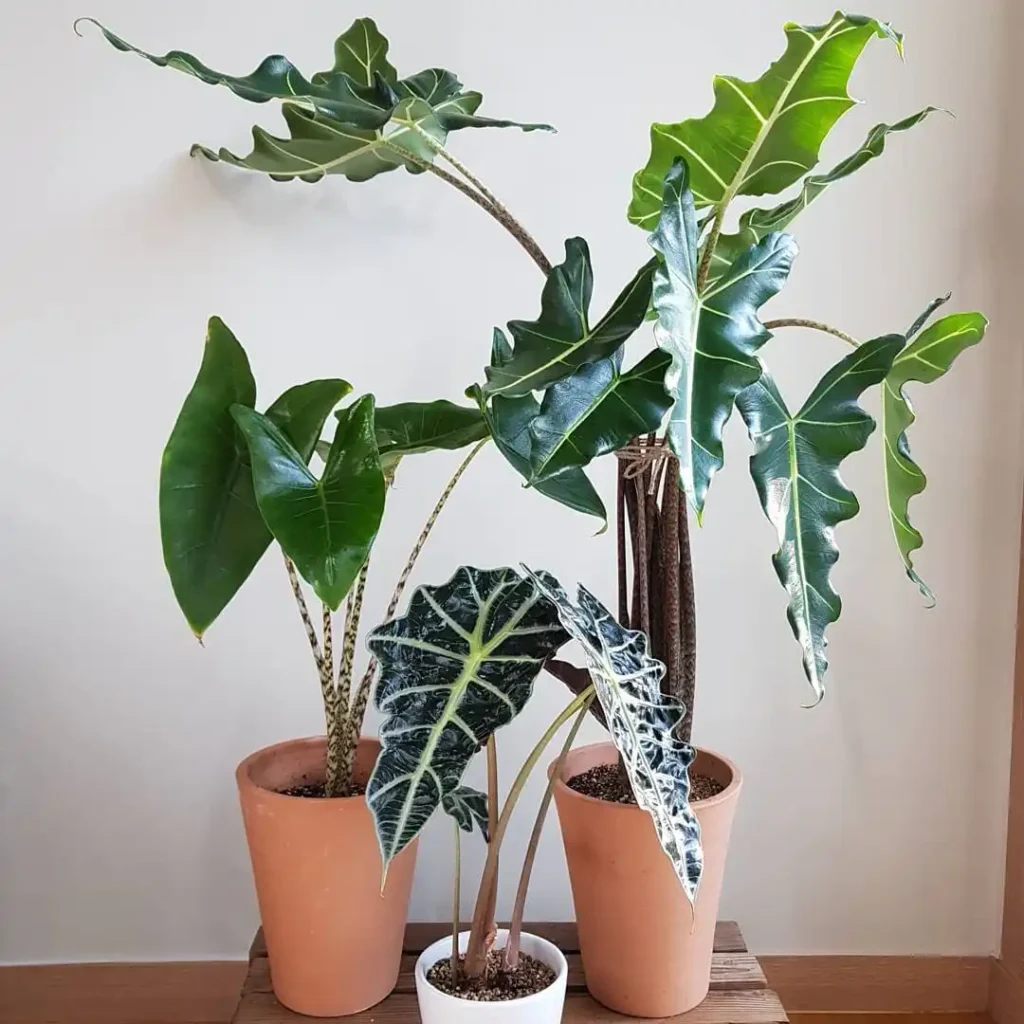
Common Problems: Troubleshooting Guide 101
“Uncommon Hurdles” plunges into the obstacles that Alocasia Sarian enthusiasts may confront while tending to their flora. Despite its robust demeanor and enthralling allure, Alocasia Sarian encounters a plethora of challenges that can impact its holistic welfare and aesthetic appeal. This section endeavors to furnish insights into discerning and surmounting these impediments through an organic, tactile methodology.
Among the customary suspects are:
- Yellowing Leaves: When foliage begins to assume a yellowish tinge, it serves as a harbinger of discord. This aberration may stem from an imbalance in irrigation, deficiencies in essential nutrients, or even overexposure to solar radiance. Discerning the underlying catalyst is pivotal in formulating a cogent strategy to rejuvenate the leaves’ verdant hue.
- Browning Leaves: The observation of brownish margins or tips on foliage can evoke despondency. This phenomenon could emanate from inadequate atmospheric moisture, excessive direct solar exposure, or erratic watering practices. Implementing alterations to the milieu and irrigation regimen can impede the progression of browning and foster more robust leaf proliferation.
- Wilting: When the foliage starts to sag and languish, it vocalizes a plea for succor from its caretaker. This malaise might ensue from underwatering, overwatering culminating in root degradation, or perturbation due to drastic thermal oscillations. Furnishing an optimal water quotient and ensuring adept drainage can resuscitate the ailing foliage and infuse vitality into the flora.
- Pests: Unwelcome guests such as aphids, mealybugs, and spider mites can unleash havoc upon Alocasia Sarian. Regular scrutinization and expeditious remedial measures employing indigenous antidotes are indispensable in warding off these interlopers and conserving the innate beauty of the plant.
- Diseases: Alocasia Sarian is not impervious to fungal maladies such as root rot or leaf spot, particularly in environments characterized by inadequate air circulation and superfluous humidity. Upholding hygienic standards, eschewing overhydration, and fostering commendable air flow can obviate the advent of maladies and perpetuate the plant’s flourishing.
Through assiduous attention and meticulous care, adherents of Alocasia Sarian can ensure the perennial’s perpetuation and proliferation, thereby imparting elation and aesthetic splendor to its surroundings in an idiosyncratic, bespoke manner.
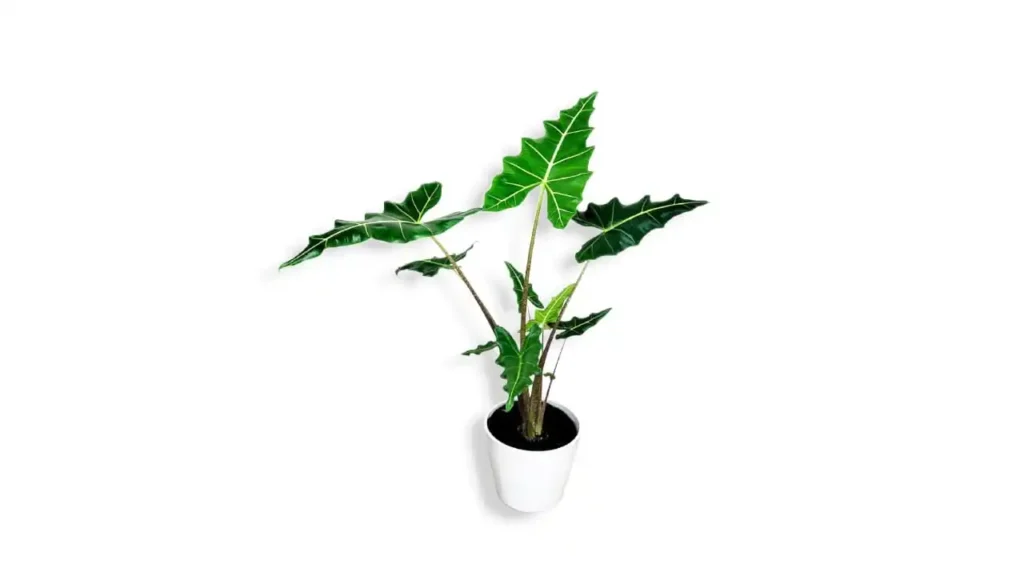
FAQs: Frequently Asked Questions
Is Alocasia Sarian suitable for beginners?
Alocasia Sarian can be challenging for beginners due to its specific care requirements. It thrives in warm, humid environments with indirect light and well-draining soil. Novice gardeners may find it daunting to maintain these conditions consistently. However, with research and dedication, beginners can successfully care for Alocasia Sarian by closely monitoring its watering, lighting, and humidity needs.
How often should I repot my Alocasia Sarian?
Repotting Alocasia Sarian should be done every 1-2 years or when the plant outgrows its current pot. Choose a pot that is slightly larger in diameter than the current one to accommodate root growth. Repotting allows the plant to access fresh nutrients and prevents it from becoming root-bound, ensuring continued healthy growth and vitality.
Can I propagate Alocasia Sarian from leaf cuttings?
While some plants can be propagated from leaf cuttings, Alocasia Sarian typically propagates more successfully through division or offsets. Propagating from leaf cuttings may yield limited success, as Alocasia Sarian prefers to produce offsets or pups that can develop into new plants with established root systems.
Why are the leaves of my Alocasia Sarian turning yellow?
Yellowing leaves on Alocasia Sarian can be caused by various factors, including overwatering, underwatering, insufficient light, or nutrient deficiencies. Assess your plant’s care routine and environmental conditions to identify the underlying cause of leaf yellowing. Adjust watering frequency, light exposure, and fertilizer application as needed to promote healthy leaf growth.
Is Alocasia Sarian safe for pets?
Alocasia Sarian is toxic to pets if ingested, causing symptoms such as oral irritation, drooling, and difficulty swallowing. It’s essential to keep the plant out of reach of curious pets and to educate household members about its toxicity. If ingestion occurs, seek veterinary attention immediately to ensure the safety and well-being of your pet.
Read Me – Phalaenopsis Orchids: The Ultimate Care And Growing Guide

